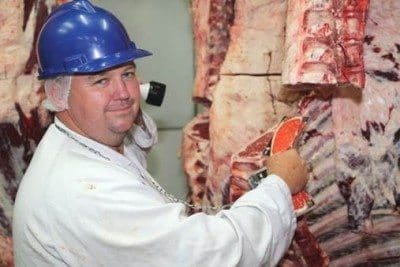IT TAKES a sharp eye, plenty of practice and a willingness to start work at 3am each day to be a Meat Standards Australia (MSA) grader, responsible for assessing the eating quality of hundreds of tonnes of beef each day.

Marty Braddick, chiller assessor at the John Dee processing plant in Warwick, Qld, says it takes about a minute to assess each carcase during MSA grading.
But for Marty Braddick, chiller assessor at the John Dee processing plant in Warwick, he wouldn’t have it any other way.
“For anyone that’s interested in the meat industry it’s a good job to get into because you learn a lot from it … and you get the afternoons off and the weekends start early,” Mr Braddick said.
“When you’re first learning the process it is hard, but once you get used to it you can match meat colour and measure the marbling a lot quicker, and then it becomes all about keeping up your accuracy.”
MSA was developed by the Australian red meat industry to improve the eating quality consistency of beef and sheepmeat. The system is based on over 700,000 consumer taste tests by over 100,000 consumers from nine countries and takes into account all factors that affect the eating quality of the 169 cuts and cooking combinations within a carcase.
To apply this research Mr Braddick must arrive at John Dee at 3am each day, where the first job is to make sure the carcases are at the right temperature for assessment.
Cattle slaughtered the previous day are chilled overnight, and must be cooled to a butt temperature of less than 20o, and under 12o at the meat quality assessment site that sits between the twelfth and thirteenth ribs.
It is then up to the assessor to open the assessment site with a knife and saw, before waiting at least 20 minutes for the meat to ‘bloom’.
“That means the meat has got its colour up,” Mr Braddick said. “For example, if you’re at a butcher’s shop you’ll see one side of the meat nice and red but the other side that has been lying on the tray will be a purple colour – that means it has not been getting any air to it. The meat needs air to bloom to its true colour.”
By this time it’s 5am and Mr Braddick is setting up his equipment for measuring and recording the key data from each and every carcase – torch and batteries, pH and temperature meter, rulers, and the comparison ‘chips’ for meat and fat colour and marbling.
Each grader carries with them an MSA data capture unit (DCU), a small hand-held computer used to record the information from each individual carcase during grading.
“It looks a bit like a hand held bar-code scanner. We scan the ticket on each body to retrieve details from the MSA Vendor Declaration like the body number and lot number, tropical breed content, sex, HGP status, their market destination, carcase hanging method and weight,” he said.
“Then I assess ossification and hump height, use the standards to take a score for meat colour and marbling content, and measure the rib fat, the pH and temperature.
“The machine will then calculate the MSA score for each cut in that carcase and report what market destination it should be grouped into – for example, different brands destined for a specific market will require different specifications to others.
“All in all it takes about one minute to assess each carcase. We have to move quickly because we only have three hours from the time of bloom to take an accurate assessment in line with the national standards.”
The team of graders at John Dee assess about 500 carcases each morning, with Mr Braddick scoring about 250 of those before 8:30am, when the data is downloaded from the DCU and entered into the MSA database.
The working day doesn’t end there though, with the rest of the morning spent sorting the carcases as they come into the chillers from the kill floor for assessment the following day.
To become a grader Mr Braddick undertook a two-week course with AusMeat as well as a two-week MSA training course. He is re-assessed every eight weeks in order to retain his accreditation, and every three months an MSA representative will meet with him face to face.
One of the more satisfying aspects of his job is providing feedback to cattlemen, with grainfed producers particularly interested in feedback regarding the marbling of their beef, which has a direct impact on their bottom line.
Top tips for producers
Mr Braddick said his top tip for producers was minimising the stress on the animals prior to slaughter.
“If the carcases have a dark meat colour, producers should check how they been transported and handled in the yards, if the animal in question has been sick or if there had been a sudden change in the weather like a cold snap or heatwave,” he said.
“When cattle start stressing they lose the glycogen, or energy, in their body which means they can’t generate enough lactic acid once slaughtered – that’s when they get dark and less tender.”
Producers are provided with MSA feedback reports direct from the processor, but the grading data is also uploaded to the myMSA website (www.mymsa.com.au) as soon as the MSA grader has finished grading for the day, allowing producers to access and analyse grading results including the MSA Index.
More information on Meat Standards Australia is available at www.mla.com.au/msa
Source: MLA
